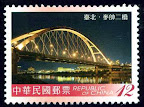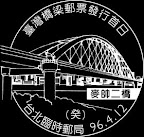



Stamp Issue : 1955-10-15

Stamp Issue : 1957-07-19


Stamp Issue : 2008-08-13
Valentré Bridge (Pont Valentré) is a 14th century fortified bridge crossing the Lot River to the west of Cahors, in France. It has become a symbol of the city. It is construction began in 1308, but it lasted for more than half a century. In 1879 it was repaired and it had some alterations. It has seven ogival arches and three towers with 40 meters in height, with defensive functions and being a very good example of the middle age military architecture. The Valentré Bridge listed as a UNESCO World Heritage Site.
瓦倫垂大橋是十四世紀的防禦工事橋樑,越過洛特河到法國卡奧爾西區,已成為這個城市的象徵,1308年開始建造,但持續了半個多世紀始建成,於1879年復建後與原來已有些改變,有7個尖頂拱門和3個40高的橋塔,作為中世紀軍事防禦功能建築的範例,瓦倫垂大橋經已被聯合國教科文組織列為世界遺產。




















